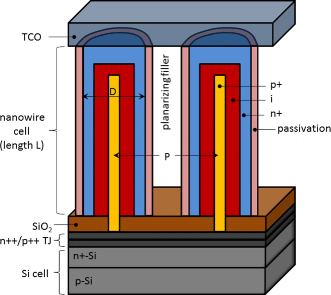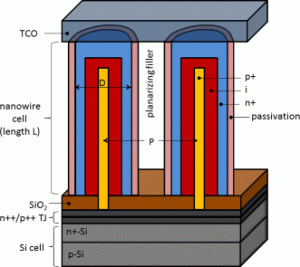Leveraging intriguing effects of quantum theory for novel real-world applications is the inevitable goal of researchers who work on nanostructures. Even though todays’ market for photovoltaic devices is largely dominated by silicon, eventually nanowires composed of group-III and group-V elements are possible candidates for combining highest efficiencies and low cost. In their review article that appeared in pss (Rapid Research Letters) Ray LaPierre et al. present state-of-the-art knowledge and outline some of the most pressing limitations associated with using nanowires of III-V materials for solar energy harvesting.
Sample preparation techniques play an important role since they ultimately determine the quality of nanowires via their crystal structure and stacking faults: The efficiency is influenced by scattering or non-radiative recombination losses. After comparing the older and well-studied catalyst-assisted growth of III-V nanowires with self-assisted growth, a method motivated by the possibility to avoid contamination with metal catalysts, the authors point out that the latter is naturally compatible with integration on silicon.
For actual applications in photovoltaic devices, however, it is not just the properties of individual wires that are important, but the interplay of diameter and distance in a large array of wires becomes relevant. LaPierre et al. discuss the anti-reflection properties of such arrays as well as the photocurrent density of entire devices. It is particularly interesting that nanowires are especially resistant to lattice mismatched growth: The strain can relax at the free surface, opening up enormous possibilities for band-gap engineering in hetero-structures.
The paper contains an elaborate compilation of solar cell performances reported in the literature and summarizes the most important challenges for nanowire-based photovoltaic devices. In particular, the authors suggest that widespread application of nanowires is promising for sunlight concentrator systems.
This review article will be part of a forthcoming Focus Issue of pss (Rapid Research Letters) (Link zu WOL, Artikelliste) on Semiconductor Nanowires that is guest-edited by Chennupati Jagadish, Lutz Geelhaar and Silvija Gradecak. The Call for Papers is currently still open for submissions (http://www.materialsviews.com/call-for-papers-focus-issue-semiconductor-nanowires-in-physica-status-solidi/) and will close May 31, 2013.


















